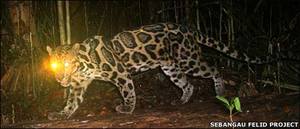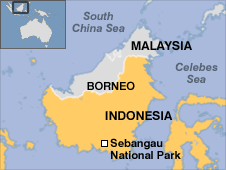
|
| ©Unknown |
| The Bornean clouded leopard was only classified as a distinct species in 2007 |
Automatic cameras have captured images of a clouded leopard in Borneo's Sebangua National Park, an area where the cats have not been recorded before.
Researchers say confirmation of the leopards' presence highlights the need to protect the region's habitat.
The park is one of the world's largest deep peat-swamp forests, but is at risk from illegal logging and forest fires.
The images are helping a team of scientists identify what big cat species are found in the area.
The motion-activated remote cameras that captured the remarkable images were located on the northern edge of the Sebangau National Park, Indonesian Borneo.

|
| ©BBC |
| Map of Borneo |
"The Bornean clouded leopard is a top priority for our programme," said Professor David Macdonald, director of Oxford University's Wildlife Conservation Research Unit, which is part of the Sebangau Felid Project.
"We are very excited by this evidence that they occur at Sebangau - a great deal remains to be discovered about these beautiful felids, which are a flagship for conservation in South-East Asia."
Camera action
Based on estimates of density and population range, the team says the clouded leopards number no more than 10,000 sexually mature adults.
The cat was first classified as a separate species in 2007 after genetic testing highlighted at least 40 differences from clouded leopards found on mainland Asia.
The project aims to protect Indonesian Borneo's wild cat species, which also include the leopard cat, marbled cat and flat-headed cat.
As well as capturing the first image of the Bornean cloud leopard (Neofelis diardi) in the park, the cameras have also photographed a number of other species, including Malaysian sun bears, bearded pigs and lesser mouse deer.
The national park is also home to the world's largest remaining population of Bornean orangutans (Pongo pygmaeus wurmbii), and a "substantial" number of Bornean southern gibbons (Hylobates albibarbis).



Reader Comments
to our Newsletter